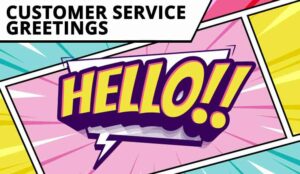Alexandra Kozma at VCC Live shares insights for customer service greetings.
Imagine that you just bought a pricey product, but it’s not working as expected. You try to figure it out, but end up wasting too much time and decide to contact support. You’re frustrated, but still have a good feeling about the purchase.
You dial in, and wait a few more minutes in line.
An agent picks up: flat, unenthusiastic tone; empty words, clearly read off their screen. You can feel that you just interrupted their Netflix marathon and they openly hate you for it.
Are you still excited about the company you purchased from?
Now picture that, after the long wait, you get connected to someone who is friendly, present and ready to help. If you’re like most of us, you forgot about half of your frustration already. Your subconscious tells you: “I was right about choosing this company.”
Choosing the proper customer service greeting can make or break your customer experience. Read on to learn how to get it right!
The 6 Rules for a Great Customer Service Greeting
Based on surveys and our own customer service experience at VCC Live, we collected some guidelines to help you come up with greetings that fit your company best. You can put them in your agents’ script to create the best first impression while saving your overwhelmed agents from decision fatigue.
1. Words Aren’t Enough
Without knowing what the first agent said in the situation above, you most likely felt repelled.
You can compose a killer customer service greeting phrase, but it’s useless if said with the wrong tone and intention. Friendly words combined with a grumpy tone is anything but authentic.
According to a study conducted by the Temkin group, emotion has greater impact on customer loyalty than the outcome of the call. They found that 86% of customers would purchase from a company again when customer support evoked the right emotions.
In other words, your customers judge your company based on how appreciated they feel.
Understand your clients’ pain, frustration, the time they’ve wasted, and treat them accordingly. Make them feel welcome and listen to them with an open mind.
2. Time Is Precious – Skip the Company Intro
These days, most customer services take the customer to an IVR menu first, where a pre-recorded voice informs them about the company they called. Why would your agents repeat the same message, wasting your clients’ time before they can get to the point?
Instead, acknowledge the long wait and start with a simple: “Thank you for waiting.”
3. Make It Personal
Avoid sounding robotic and scripted. Offer a few variations for your agents, depending on their personalities, the time of the day and other situations.
Based on the survey results, most customers preferred to be greeted with “Good morning/good afternoon” rather than “Welcome to XY,” a greeting that most of us don’t use in person.
Don’t cross any lines by being overly friendly, but you can start with a “How is your day going?” Not everyone likes this, but often it will brighten your client’s day.
4. Don’t Be Too Formal
Business casual is the new norm – formal, corporate language tends to create distance. Your customers might find it harder to trust you if you sound overly stiff.
According to the survey results, most customers preferred to be greeted with “Hi” over “Hello“, and using language like “How can I help you?” was more popular than: “How may I help you?”
Casual doesn’t equal disrespectful or unprofessional. It simply means creating closer connections with your clients.
Please note: While casual language is now preferred in many countries and industries, your culture might be different. If your customers insist on talking in a formal way, don’t force this.
5. Use Pronouns
Pronouns like you, I, your, my can help establish a personal connection. These are powerful words on our subconscious, creating more involvement on both sides.
The customer feels more seen hearing the you/your pronouns, and trusts that the agent will treat their case with priority when they attach themselves to it with the I/ my pronouns.
The easiest way to do this is by adding “How can I help you?” Or “What can I do for you today?” to your introduction.
6. Remember to Add Names
Over 94% of customers agreed that the agent should always introduce themselves. This is another effective way to build rapport and trust, and to keep things more personal.
Is the caller not in your database yet? Ask for their name too! Not only does it make administration easier, but you can use their name during the conversation.
The next time they reach out, your agents can call them by their name before they introduce themselves. What a great way to show your clients how much they matter!
Some Examples of Great Customer Service Greeting Phrases:
- Hi, this is [agent name]. How can I help you today?
- Good morning, [agent name] speaking. What can I do for you?
- Thank you for waiting! My name is [agent name]. How can I assist you?
- Hi [customer name], thank you for calling us! How are you today?
- Good afternoon, welcome to [company name]. I’m [agent name]. What can I help you with today?
Let Your Agents Create Their Own Customer Service Greeting
The greetings we listed in this article will help you get started, but be sure to finetune them as you go.
Involve your agents in the process too – they might know your customers better than anyone else at your company.
The most authentic, genuine customer service greetings are the ones that match your agents’ personalities, and in turn, they will feel more comfortable about picking up the phone.
Author: Guest Author
Published On: 18th Feb 2021 - Last modified: 23rd Feb 2021
Read more about - Guest Blogs, VCC Live















